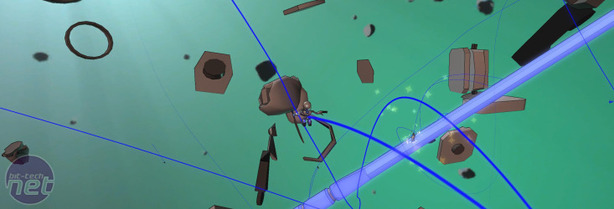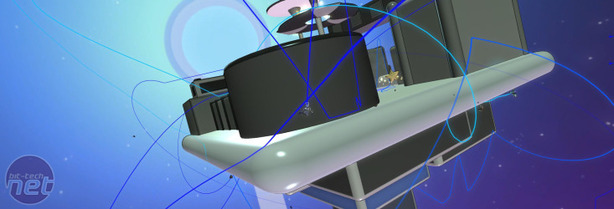
Out of Mind
What helps make Plain Sight unique beyond the cutesy graphics and high-speed ninja swords though is the insanity with which levels have been designed.All robots move faster through the air than they do over the ground which encourages you to jump around like a loon, but all of Plain Sight’s levels are suspended in space, so, to stop players spiralling off into the emptiness like trampolining astronauts, there’s a powerful directional gravity effect which pulls you down to whatever surface is directly beneath you.
Couple that with the crazed level design, which includes tiny two-sided cities and broken cassette tapes adrift in the void, and you quickly begin to understand how deliriously disorientating Plain Sight can be. Vaulting from one platform to another can sometimes leave you arcing through the air like a fish in the middle of a tidal wave. Navigating the surreal arenas requires both luck and hope, because the slightest slip can send your slingshot terribly awry.
Adding a touch of depth to the pretty lights and gleeful freefalling is a simple RPG systems which lets you upgrade your character with XP earned from kills, ploughing points into new abilities and speed improvements. The only disappointment there is that it sometimes reduces the game to a frustrating stalemate – you can lock-on to an enemy and dash at him with perfect aim only to be repelled by a last minute block. The correct skill combos let you detect and repel incoming attacks with ease.
Further player advantages show up in the form of power-ups that litter the levels, ranging from Flaming Katanas to Stealth Modes, but the effect and importance of these is generally minimal. It’s far more important to master the timing of the lock-on system than it is to bother hunting for power-ups because they generally don’t give you much of an appreciable edge.
Lack of variety is a bit of an issue for Plain Sight though as, while there are a fair few modes available, they all iterate on the main premise of charging other robots and then blowing yourself up - a fact which means the initial inventiveness of modes like Botzilla quickly wear off. Nearly every game we saw online stuck with the vanilla Deathmatch mode, because it's there that the Plain Sight is the most fun.
Visually though, there’s a lot of nice touches in Plain Sight that indicate a thoughtful design and great attention to detail. Environments themselves are mostly built out of muted greys and blacks, which sounds dull but is actually a way of making the lightning-fast robots stand out and easier to track. Players have long neon trails behind them for the same reason, while those with a lot of points will get steadily bigger and brighter unless they self-detonate – focusing vindictive sorts on fighting those who have the most to lose.
 Good as the game looks though, there are some concerns, with the main one being both the game’s biggest strength and it’s greatest weakness; simplicity. On the one hand it means that Plain Sight is incredibly easy to pick up; you can jump in and start bounding through the wacky levels in just a matter of minutes. On the other hand, the stark simplicity of Plain Sight makes the replay value for anyone but the most adept players a bit of an uncertainty.
Good as the game looks though, there are some concerns, with the main one being both the game’s biggest strength and it’s greatest weakness; simplicity. On the one hand it means that Plain Sight is incredibly easy to pick up; you can jump in and start bounding through the wacky levels in just a matter of minutes. On the other hand, the stark simplicity of Plain Sight makes the replay value for anyone but the most adept players a bit of an uncertainty. Personally, we quite like Plain Sight right now, but we doubt whether we'll be playing it come the end of next week – and in the meantime it doesn’t really encourage extended playtimes. It’s very much the type of game you’ll pop in and play for 20 minutes at a time, rather than investing hours in without a break.
To be completely fair though, this has all been reflected in the price and Plain Sight doesn’t make any allusions to being an epic singleplayer experience. It presents itself quite clearly as a fast-paced but throwaway action platformer - and a fun one at that. Still, at the end of the day it’s great while it holds your attention, but it frankly isn’t able to hold on to it very long.
Score Guide

MSI MPG Velox 100R Chassis Review
October 14 2021 | 15:04











Want to comment? Please log in.